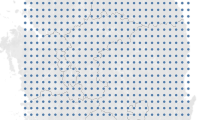Abstract
Convolutional Neural Network (CNN) is one of the main deep learning algorithms that has gained increasing popularity in a variety of domains across the globe. In this paper, we use U-net, one of the CNN architectures, to predict spatial PM2.5 concentrations for each 500 m × 500 m grid in Beijing. Different aspects of data including satellite data, meteorological data, high density PM2.5 monitoring data and topography data were taken into consideration. The temporal and spatial distribution patterns of PM2.5 concentrations can be learned from the result. Then, a customized threshold was added for each predicted grid PM2.5 concentration to define high-value areas to find precise location of potential PM2.5 discharge events.
Access this chapter
Tax calculation will be finalised at checkout
Purchases are for personal use only
Similar content being viewed by others
References
Lv, B., Hu, Y.: Improving the accuracy of daily PM2. 5 distributions derived from the fusion of ground-level measurements with aerosol optical depth observations, a case study in north China. Environ. Sci. Technol. 50(9), 4752–4759 (2016)
Jiao, L., Xu, G.: LUR-based Simulation of the Spatial Distribution of PM2.5 of Wuhan. Geomatics and Information Science of Wuhan University, vol. 40, no. 8, pp. 1088–1093 (2015). (in Chinese)
Beckerman, B.S., Jerrett, M.: A hybrid approach to estimating national scale spatiotemporal variability of PM2.5 in the contiguous United States. Environ. Sci. Technol. 47(13), 7233–7241 (2013)
Huang, X.H.H., Bian, Q.: Characterization of PM2.5 major components and source investigation in suburban Hong Kong: a one year monitoring study. Aerosol Air Quality Res. 14, 237–250 (2014)
Wang, J., Christopher, S.A.: Intercomparison between satellite -derived aerosol optical thickness and PM2.5 mass: implications for air quality studies. Geophys. Res. Lett. 30(21), 2095–2099 (2003)
Liu, Y., Sarnat, J.A.: Estimating ground-level PM2.5 in the Eastern United States using satellite remote sensing. Environ. Sci. Technol. 39(9), 3269–3278 (2005)
Schaap, M., Apituley, A.: Exploring the relation between aerosol optical depth and PM2.5 at Cabauw, the Netherlands. Atmos. Chem. Phys. 9(3), 909–925 (2009)
van Donkelaar, A., Martin, R.V.: Estimating ground-level PM2.5 using aerosol optical depth determined from satellite remote sensing. J. Geophys. Res. Atmos. 111, D21201 (2006)
Pu, L., Zhu, H.: Application of satellite remote sensing to ground-level PM2.5 concentration estimation in Shanghai. Shanghai Municipal Center for Disease Control and Prevention, vol. 34, no. 2, pp. 99–105 (2017). (in Chinese)
Boys, B.L., Martin, R.V.: Fifteen-year global time series of satellite-derived fine particulate matter. Environ. Sci. Technol. 48(19), 11109–11118 (2014)
Liu, Y., Paciorek, C.J.: Estimating regional spatial and temporal variability of PM2.5 concentrations using satellite data, meteorology, and land use information. Environ. Health Perspect. 117(6), 886–892 (2009)
Véstias, M.P.: A survey of convolutional neural networks on edge with reconfigurable computing. Algorithms 12(8), 154–177 (2019)
Sharma, N., Jain, V.: An analysis of convolutional neural networks for image classification. Procedia Comput. Sci. 132, 377–384 (2018)
Yamashita, R., Nishio, M., Do, R.K.G., Togashi, K.: Convolutional neural networks: an overview and application in radiology. Insights Imaging 9(4), 611–629 (2018). https://doi.org/10.1007/s13244-018-0639-9
Ronneberger, O., Fischer, P., Brox, T.: U-Net: convolutional networks for biomedical image segmentation. In: Navab, N., Hornegger, J., Wells, W.M., Frangi, A.F. (eds.) MICCAI 2015. LNCS, vol. 9351, pp. 234–241. Springer, Cham (2015). https://doi.org/10.1007/978-3-319-24574-4_28
Li, J., Zhang, J.: Comparison of spatial interpolation methods of meteorological elements. Pratacultural Sci. 23(8), 6–11 (2006). (in Chinese)
Author information
Authors and Affiliations
Editor information
Editors and Affiliations
Rights and permissions
Copyright information
© 2021 The Author(s), under exclusive license to Springer Nature Switzerland AG
About this paper
Cite this paper
Wang, F. et al. (2021). A U-net Architecture Based Model for Precise Air Pollution Concentration Monitoring. In: Qiu, R., Lyons, K., Chen, W. (eds) AI and Analytics for Smart Cities and Service Systems. ICSS 2021. Lecture Notes in Operations Research. Springer, Cham. https://doi.org/10.1007/978-3-030-90275-9_6
Download citation
DOI: https://doi.org/10.1007/978-3-030-90275-9_6
Published:
Publisher Name: Springer, Cham
Print ISBN: 978-3-030-90274-2
Online ISBN: 978-3-030-90275-9
eBook Packages: Business and ManagementBusiness and Management (R0)




